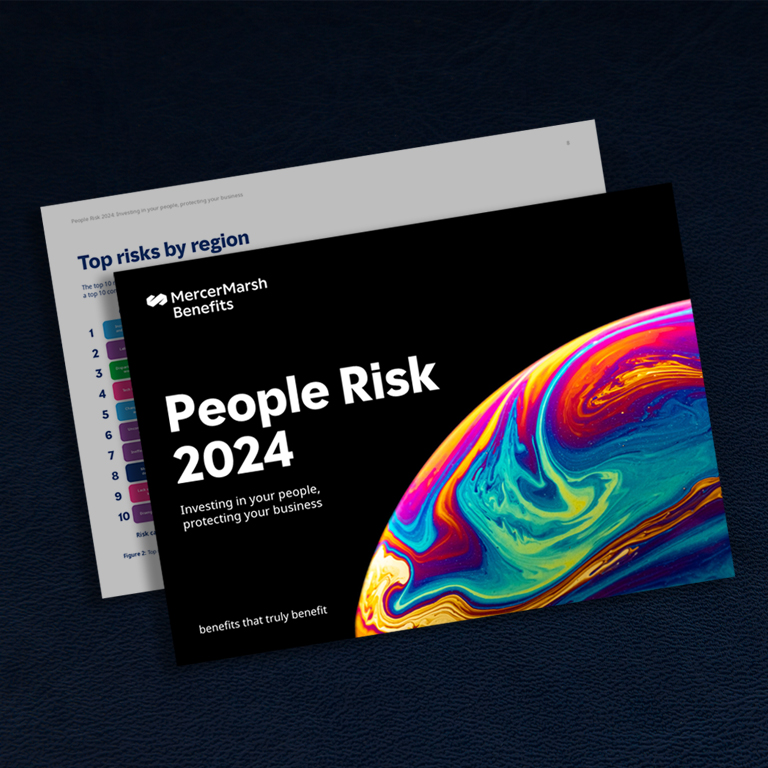
Reid Sawyer
Managing Director, Head Emerging Risks Group, Marsh
The pandemic forced many organisations to take a technology-first approach. In many ways, this has been positive for employees as they value access to virtual health benefits, a more flexible approach to working, and a focus on social inclusion and mental health.
Now, forward-thinking employers should be prioritising digital initiatives to promote a positive experience across all HR-related activities. Personalisation is the aim as firms attempt to create the most relevant benefits experience possible to attract and retain talent within a diverse workforce. Employees are more resilient if offered a broad range of benefits, but more choice means a greater need for digital options to simplify benefits delivery.
Rapid change and complexity can bring cybersecurity risk as well as workforce exhaustion in relation to transformation, skills gaps, and HR technology obsolescence. Organisations must take a proactive approach and have open conversations about why technology change is necessary, what items are on the roadmap to be implemented, how to prepare for change, and how to execute on such change in an empathetic manner to minimise frustration and anxiety.
For the second year running, the People Risk Report 2022 research showed that HR and risk professionals ranked cybersecurity as the number one risk-facing business. While 76% of respondents feel their organisation is addressing cybersecurity risk, only 44% report having effective policies, controls, and support systems in place, and more than one-third (35%) feel they lack the skilled resources to understand and address the exposure. This aligns with the recent Marsh and Microsoft 2022 Global Cyber Risk Perception Survey, which shows that 40% of firms say their cyber hygiene needs improvement.
Testing of systems throughout implementation together with investment in appropriate training for employees is critical to ensuring secure platforms. The Marsh-Microsoft study indicates that 43% of organisations have conducted a risk assessment of their vendor/supply chain. Cooperation is necessary across the entire enterprise; this requires broad-based communication and alignment between stakeholders during key decision-making moments of truth along their cyber resilience journey. For example, all departments that touch cyber risk should be involved in cyber incident management, and cyber insights should be shared across the enterprise to appropriately address weak spots in organisational cybersecurity. HR is often missing from the table.
The top people risk that faces businesses today is cybersecurity and data privacy, and the World Economic Forum’s Global Risks Report 2022 highlights that 95% of cyber issues have been traced to human error.
Administration of employee benefit plans is a critical area of exposure. As sensitive health claims information is transferred by third parties, and in some instances internally to manage benefits, firms may need to consider putting more stringent processes in place to keep data secure.
Another key concern is HR technology obsolescence, which is ranked 11th out of 25 risks for employers. While there has been an increase in the number of employees who agree that “my HR technology at work is very joined up” (61%), there’s clearly still some way to go.
Benefits may be provided by an organisation, but they must be communicated and promoted to gain effective use.
How employees access their benefits fits into the employee experience. The ability to integrate work and personal lives is linked to productivity. When it comes to enrolling and consuming their benefits, people increasingly expect a “consumer-grade” experience that is similar to when they make purchases from an online retailer. Employees need their benefits at moments that matter, right at the fingertips on any device, anywhere, and at any time. Our Age of Adaptability research found that when employees are provided with a consumer-grade experience, they are much more likely to feel as though they have “highly relevant” benefits; this also allows them to stay more connected to their organisation.
Centralised, automated benefits administration removes the risks of manual data handling and associated security breaches. This should include seamless and secure integrations with existing HR systems, including controlled data access and robust file encryption.
Look at how you can create a digital front door to benefits and other employee supports to help people easily access programs and content, integrated with other HR experiences.
Alongside this emphasis on choice and personalisation, it is critical to promote cyber literacy among employee populations with a focus on learning and development.
HR, in conjunction with risk, should focus on where cybersecurity vulnerabilities exist within current employees’ day-to-day activities. This means evaluating everything from administrative access to sensitive information to remote work policies.
Firms must prioritise making sure that benefits data is secure. Extensive data security measures mean employees can access and engage in their benefits safely from any device, anywhere in the world.
Save time and money with automated administrative processes and employee self-service, including employee management of spending account reimbursements.
Improve efficiencies and streamline workflows with integrated auto-enrollment and extensive reporting and audit functionality.
Review the 12 cybersecurity controls recognised by cybersecurity experts to help prevent, respond, minimise and recover from a cyberattack.
There is no turning back from the digitisation of employee benefits and other components of the employee experience. Organisations must seize the exciting opportunities this brings, like opening up access to affordable and convenient healthcare, while managing the risks of cybersecurity and evolving data privacy legislation.
A critical component of this strategy is tactics to support the attraction, retention, and engagement of individuals with the required skills. In this respect, companies should look to the technology sector and the workforce itself for inspiration regarding benefits, culture, working conditions, and other components of rewards that will bring resilience to the workforce and businesses alike.

Managing Director, Head Emerging Risks Group, Marsh

Digital Health Leader, MMB

Report
23/04/2024